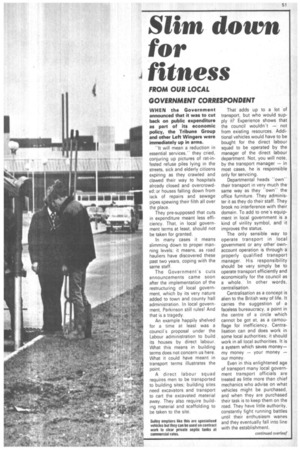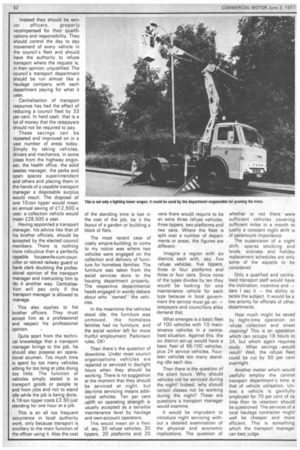Slim down for fitness
Page 53

Page 54

If you've noticed an error in this article please click here to report it so we can fix it.
FROM OUR LOCAL GOVERNMENT CORRESPONDENT
WHEN the Government announced that it was to cut back on public expenditure as part of its economic policy, the Tribune Group and other Left Wingers were immediately up in arms.
"It will mean a reduction in essential services,'' they cried, conjuring up pictures of rat-in fested refuse piles lying in the streets, sick and elderly citizens expiring as they crawled and clawed their way to hospitals already closed and overcrowded; or houses falling down from lack of repairs and sewage pipes spewing their filth all over the place.
They pre-supposed that cuts in expenditure meant less efficiency. That in local government terms at least, should not be taken for granted.
In many cases it means slimming down to proper manning levels; it means, as road hauliers have discovered these past two years, coping with the same staff.
The Government's cuts announcements came soon after the implementation of the restructuring of local government, which by its very nature added to town and county hall administration. In local government, Parkinson still rules! And that is a tragedy.
An example happily shelved for a time at least was a council's proposal under the Labour administration to build , its houses by direct labour. What this means in building terms does not concern us here. What it could have meant in transport terms illustrates the point.
A direct labour squad requires men to be transported to building sites; building sites need excavators and transport to cart the excavated material away. They also require building material and scaffolding to be taken to the site. That adds up to a lot of transport, but who would sup ply it? Experience shows that the council wouldn't — not from existing resources. Additional vehicles would have to be bought for the direct labour squad to be operated by the manager of the direct labour department. Not, you will note, by the transport manager -in most cases, he is responsible only for servicing.
Departmental heads "own" their transport in very much the same way as they "own" the office furniture. They administer it as they do their staff. They brook no interference with their domain. To add to one's equipment in local government is a kind of virility symbol, and it improves the status.
The only sensible way to operate transport in local
government or any other.own
account operation is through a properly qualified transport manager. His responsibility should be very simply be to operate transport efficiently and
economically for the council as a whole.In other words, centralisation.
Centralisation as a concept is alien to the British way of life. It carries the suggestion of a faceless bureaucracy, a point in the centre of a circle which cannot be got at, as a camou flage for inefficiency. Centralisation can and does work in some local authorities; it should work in all local authorities. It is a system which saves money— my money -your money -our money.
Even in this enlightened age of transport many local govern ment transport officials are treated as little more than chief mechanics who advise on what vehicles might be purchased, and when they are purchased their task is to keep them on the road. They have little authority, constantly fight running battles until their enthusiasm wanes and they eventually fall into line with the establishment. Instead they should be sen ior officers, properly recompensed for their qualifi cations and responsibility. They should control the day to day movement of every vehicle in the council's fleet and should have the authority to refuse transport where the request is, in their opinion, unjustified. The council's transport department should be run almost like a haulage company with each department paying for what it uses.
Centralisation of transport resources has had the effect of reducing a council fleet by 33 per cent. In hard cash, that is a lot of money that the ratepayers should not be required to pay.
These savings can be repeated and improved on in a vast number of areas today. Simply by taking vehicles, drivers and mechanics, in some cases from the highway engineer, the health office, the solid wastes manager, the parks and open spaces superintendent and others and placing them in the hands of a capable transport manager a disposable surplus would result. The disposal of one 10-ton tipper would mean an annual saving of £12,500 a year; a collection vehicle would mean £28,500 a year.
• Having appointed a transport manager. his advice like that of his brother officials, should be accepted by the elected council members. There is nothing more ridiculous than a perfectly capable housewife-cum-councillor or retired railway guard or bank clerk doubting the professional opinion of the transport manager and instructing him to -do it another way. Centralisation will pay only if the
• transport manager is allowed to manage.
• This also applies to his brother officers. They must accept him as a professional and respect his professional opinion.
Quite apart from the technical knowledge that a transport manager brings to the job, he should also possess an operational acumen. Too much time is spent by too many vehicles sitting for too long at jobs doing too little. The function of vehicles simply stated is to transport goods or people to and from jobs and not to stand idle while the job is being done. A 16-ton tipper costs £3.50 just standing for one hour at a job.
This is an all too frequent occurrence in local authority work, only because transport is ancillary to the main function of the officer using it. Also the cost of the standing time is lost in the cost of the job, be it the layout of a garden or building a block of flats.
The most recent case of costly empire-building to come to my notice was where two vehicles were engaged on the collection and delivery of furniture for homeless families. The furniture was taken from the social services store to the housing department property. The respective departmental heads engaged in wordy debate about who "owned— the vehicles.
In the meantime the vehicles stood idle, the furniture was unmoved, the homeless. families had no furniture, and the social worker left for more fruitful employment. Parkinson rules, OK!
Then there's the question of downtime. Under most council organisations vehicles are repaired or serviced in daylight hours when they should be working. There is no suggestion at the moment that they should be serviced at night, but day-time servicing means additional vehicles. Ten per cent uplift on operating strength is usually accepted as a 'sensible maintenance level by haulage and own-account operators.
This would mean on a fleet of, say, 30 refuse vehicles, 30 tippers, 20 platforms and 20 vans there would require to be an extra three refuse vehicles, three tippers, two platforms and two vans. Where the fleet is split over a number of departments or areas, the figures are different.
Imagine a region with six districts each with, say, five refuse vehicles, five tippers, three or four platforms and three or four vans. Since none of the types divides by ten they would be looking for one maintenance vehicle for each type because in local government the service must go on -ratepayers and councillors alike demand that.
What emerges is a basic fleet of 100 vehicles with 10 maintenance vehicles in a centralised situation. Against this, the six district set-up would have a basic fleet of 96-100 vehicles, plus 24 service vehicles. Fourteen vehicles too many standing idle each day.
Then there is the question of the silent hours. Why should vehicles not be serviced during the night? Indeed, why should certain classes not be working during the night? These are questions a transport manager would examine.
It would be imprudent to introduce night servicing without a detailed examination of the physical and economic implications. The question of
whether or not there were sufficient vehicles covering sufficient miles in a month to justify a constant night shift is of paramount importance.
The supervision of a night _shift, spares stocking and levels, sickness and holiday replacement schedules are only some of the aspects to be considered.
Only a qualified and centreused transport staff would have the inclination, incentive and -dare I say it -the ability to tackle the subject. It would be.a low priority for officials of other departments.
How much might be saved by night-time operation on refuse collection and street cleaning:? This is an operation which can occupy 18 hours in 24, but which again requires study. What savings would result? Well, the refuse fleet could be cut by 50 per cent overnight.
Another matter which would usefully employ the central transport department's time is that of vehicle utilisation. Unless a vehicle is gainfully employed for 70 per cent of its time then its retention should be questioned. The services of a local haulage contractor might well be cheaper and more efficient. This is something which the transport manager can best judge.




















































































































